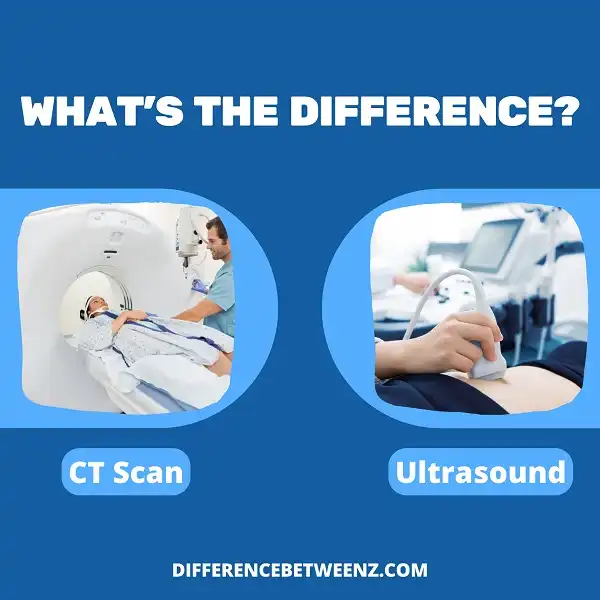CT scan vs. Ultrasound
What is the difference between CT scan and Ultrasound? There are numerous diagnostic tools used by radiology departments to diagnose diseases. Each tool has specific purposes, such as X-rays for broken bones or MRI for diagnoses in soft tissues. Radiologists can use them to give more precise diagnoses or to have a better view of the areas that concern them. This article focuses specifically on the differences between CT and CAT (Computerized Axial Tomography) scanning and Ultrasound scans.
Difference between CT scan and Ultrasound
Purpose
CT scanners are diagnostic tools that are used for many purposes. Basically CTs send x-rays through the body in small portions, which are stored as images on the computer. There is a special type of CT scanner called Fluoroscopy, which can capture live movements for certain diagnostic studies or to guide a radiological intervention when a biopsy is performed in order to guide the needle into the organ.
Ultrasonic imaging has multiple purposes allowing the radiologist to make more accurate diagnoses. Ultrasound uses high-frequency sound waves to produce a grayscale image of various organs such as the abdominals or the heart and is frequently used for fetal examinations. We have all seen a fetal ultrasound that clearly shows a baby in the picture. Doppler ultrasound allows the technician to capture blood flow ranges such as the carotid or renal arteries.
Functionality
The CT is a modality that sends x-rays to the body every time the scanner rotates and so the x-ray image is taken. Sometimes the patient is injected with a contrasting ink, thus making the internal organs; tumors and blood flow somewhat more noticeable, thus allowing the radiologist to make a more accurate diagnosis. The images are displayed on a monitor for radiologist observation.
Ultrasound emits sound waves in the patient’s body. These waves bounce off the organs and tissues inside the body, thus returning to the ultrasound transmitter. The transmitter interprets these sounds and produces an image that is displayed on a monitor. Measurements can be made for the size and depth, blood flow, or flow constriction that is kept by the technician for the radiologist’s eyesight.
History
The CT modality was invented by the engineer and physicist Godfrey Hounsfield and by Allan Cormack in 1972. Originally, it had a small opening and was used to make images of the head. When the technology improved, the opening was larger and allowed the patient’s entire body to be scanned. Originally it took several hours to acquire data and thus reconstruct them in an image, nowadays it only takes a few moments.
Ultrasound is familiar to us because it has been used in movies and television programs; however, few people know when it was invented. There are many controversies, but the first time it was reported was at the Naval Medical Research Institute in the 1940s when Dr. George Ludwig was able to prove that gallstones could be detected and then in 1957 when Dr. Ian Donald used it. First time for fetal images.
In Summary:
- CTs send x-rays through the body in small amounts, which allows images to be stored on the computer, while ultrasound images serve many purposes, allowing the radiologist to make more precise diagnoses.
- The ultrasound transmitter emits sound waves inside the patient’s body. But with a CT scanner the patient is sometimes injected with a contrast ink so that it can be more visible.


